Monday, 11 June, Immersed in Klimt and then the Trou Gascon
Written 13 June 2018
Monday morning, and you'd think that that meant everything would be open, but no. Monday is the closing day of both the Marché des Enfants Rouges (Paris's oldest covered market, which I was looking forward to exploring) and the bakery I hoped to patronize regularly. In fact, many of the businesses along the normally busy rue de Bretagne close on Monday, because foot traffic is so much less when the covered market is closed. So I went back to the chain bakery (which is always open) for a half baguette and a pain au chocolat for my breakfast and brought them back to the apartment, where I made myself a cup of tea. That salty Breton butter I bought is great!
David was still sleeping, but I knew one thing that would be open was the metro, so I set out to buy our "Navigo" transit cards. Back in the day (before chips and tap cards) when we used to spend a week at a time in Paris, we carried "orange cards." To get one, you had to show up at a manned metro station and present yourself, with a recent passport photo. The guy on duty would paste the photo onto a preformatted card, which you then signed before he laminated it into a flexible plastic case with a little plastic pouch on the outside. Then you bought a coupon, good from Monday to Monday, which looked and functioned just like a metro ticket. To enter, you pulled out the coupon, ran it through the machine at the turnstyle, then retrieved it and tucked it back into its pouch for next time. The catch was that the ticket readers on buses ruined the coupons for metro use, so on buses, you just showed your orange card to the driver. The cards were good from year to year; you just bought a new coupon each trip. We still have ours.
All that I had read about the new Navigo cards implied that you could buy them by credit card from vending machines, but we had spare passport photos, so we brought them along just in case. Good thing, as it turns out you can recharge your Navigo from a vending machine, but the guy behind the little window still has to issue the original card, and yes, he wants a passport photo. He also wants a signature, but he was fine with my signing for David. He trimmed the photos to fit, pasted them in place, had me sign the cards, attached them to chip-equipped cards, and slide them into rigid plastic cases. You just slide them, rigid case and all, over a reader at the turnstile, on any form of transport. Slick. I charged them for the month of June, since we leave on the 29th and that was cheaper than buying three one-week charges and also than buying an assemblage of 1- to 5-day tourist passes (which in any case wouldn't take us as far afield).
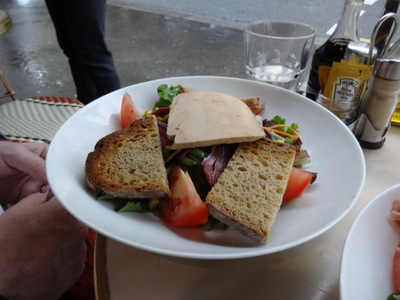
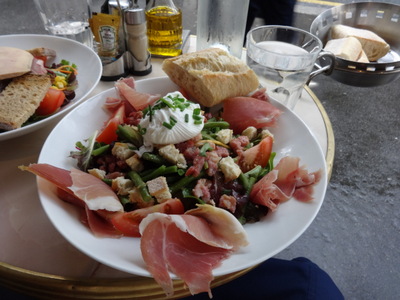 I finally woke David about noon, and we strolled to a nearby six-way intersection for lunch at a brasserie called Le Progres. He had a salad featuring greens, cold green beans, tomatoes, toast, and a slice of foie gras. I had one consisting of greens, green beans, lardons, slices of ham, croutons, and a poached eggs. Note, in the upper right corner of the photo, the clever metal bread basket that hangs off the edge of the table. Fortunately, the awning was wide enough that the bread did not stick out into the rain, although it was close. I thought I saw a name printed on the placemats that I recognized, so I looked it up on line later, and yes, the Progres is owned by Serge Blanco, former rugby player and now clothing tycoon and entrepreneur. For an account of our stay in his luxury hotel in Anglet, see my block entry at https://www.bio.fsu.edu/~thistle/blog06/06-06-29b.html.
I finally woke David about noon, and we strolled to a nearby six-way intersection for lunch at a brasserie called Le Progres. He had a salad featuring greens, cold green beans, tomatoes, toast, and a slice of foie gras. I had one consisting of greens, green beans, lardons, slices of ham, croutons, and a poached eggs. Note, in the upper right corner of the photo, the clever metal bread basket that hangs off the edge of the table. Fortunately, the awning was wide enough that the bread did not stick out into the rain, although it was close. I thought I saw a name printed on the placemats that I recognized, so I looked it up on line later, and yes, the Progres is owned by Serge Blanco, former rugby player and now clothing tycoon and entrepreneur. For an account of our stay in his luxury hotel in Anglet, see my block entry at https://www.bio.fsu.edu/~thistle/blog06/06-06-29b.html.
we debated rather to take the bus or the metro to the Atelier des Lumières, trying to guess whether the rain was letting up or getting worse, and in the end settled on the metro. The transit cards make it very easy, and we didn't get as wet as we might have waiting for the bus.
In 2013, when we visited Les Baux, in the south of France (yes, the locality for which bauxite is named, but the French don't consider that its main claim to fame), everyone we met as we toured the famous ruins raved about the nearby, newly opened "Carrière deb la lumière," the "Quarry of Light." Our ticket stubs for the ruins were good for admission there, and it was within walking distance, so we gave it a look. Here's part of my description from that time: "The premise was odd. The quarry is really a quarry—the source of large amounts of calcareous building stone—but it's not an open pit but a huge, ramifying set of tunnels. The tunnels are huge in both senses; that is, they are quite extensive, and they are also very large, as you can see from the photo of the entrance at the left above. Inside, you can see the rectangular traces on the walls of the big blocks of rock that have been removed. Somewhere along the line, somebody had the idea that those tall, rough, white walls would make good surfaces on which to project images. When you walk in through the final door into the main galleries, you find yourself in darkness, surrounded by huge projected images. When we arrived, the images were of sea life, real and imaginary, sliding and shifting around the walls, but that was apparently just the 'short subject'. The real show was paintings by the impressionists (and pre- and postimpressionists) projected on every vertical surface. The floors were on several levels, connected by ramps and stairs, and the gigantic chambers were supported by gigantic square pillars left for the purpose during the quarrying process. Projectors were strategically placed to put images on every side of every pillar, every wall, in such a way that the passing spectators never cast shadows on them. The images came and went, shifted and slid, to be replaced by others. You saw a different selection, depending on where you stood or wandered." You can see the images at https://www.bio.fsu.edu/~thistle/blog13/13-05-17.html.
Then, this last spring, when Rachel Sinnett pointed out that we would be in Paris at the right time for a special "immersive" Klimt exhibition, the exhibition's description made clear that it was set up on similar lines. The venue is called the "Atelier des Lumières," which I took at the time to mean "Studio of Light," but our visit to it made clear that it's actually "Workshop of Light"—the word can mean either one; both portrait painters and industrial welders work in "ateliers."
The same organization (Culturespaces, which manages many cultural and historical spaces around France) found the Les Baux operation so successful that they opened this second one in Paris. The Paris site originally housed a large industrial foundry, and the vast empty interior space has been used much as the quarry was. It's just one room, so the only projection surfaces are the four walls, the floor, and a large vertical cylinder (perhaps 15 or 20 feet in diameter) that rises up through it, somewhat off center.
Written 14 June 2018
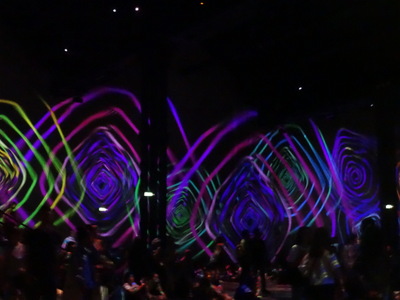
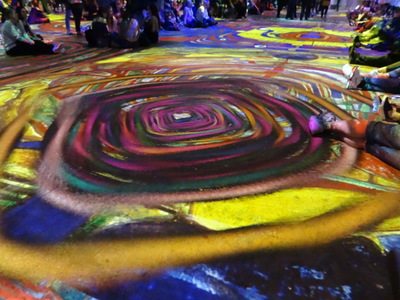 The program consisted of a short subject (on the painter Friedrich Stowasser (1928–2000), better known by his pseudonym Friedensreich Regentag Dunkelbunt Hundertwasser), an even shorter subject called "Poetic AI," and the main feature on Klimt, and it was great; we sat through the whole thing twice. All of it was set, and often synchronized, to period- and theme-appropriate music.
The program consisted of a short subject (on the painter Friedrich Stowasser (1928–2000), better known by his pseudonym Friedensreich Regentag Dunkelbunt Hundertwasser), an even shorter subject called "Poetic AI," and the main feature on Klimt, and it was great; we sat through the whole thing twice. All of it was set, and often synchronized, to period- and theme-appropriate music.
The projections photographed surprisingly well, although I had trouble with blurring because the light was so low and the images were usually moving. These first two images are of Hundertwasser, at the left on the wall and at the right on the floor. Both whirled and spun.
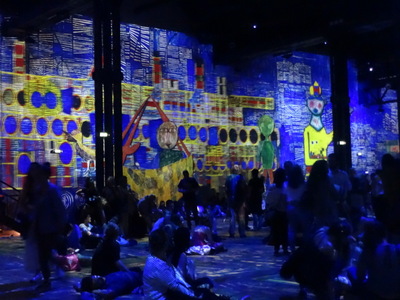
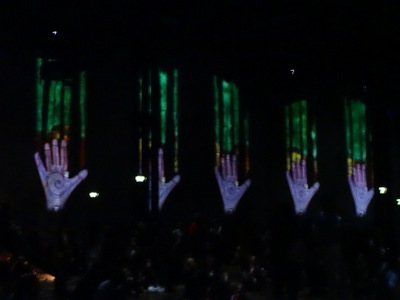 Here are two more Hundertwassers. At the left is the stern of a ship that has just sailed from right to left across the wall, as the buildings behind it remained stationary. You can see, e.g., its red and white smokestacks and its round portholes.
Here are two more Hundertwassers. At the left is the stern of a ship that has just sailed from right to left across the wall, as the buildings behind it remained stationary. You can see, e.g., its red and white smokestacks and its round portholes.
At the right are five hands that slid slowly down the wall, leaving green fingermarks (or claw marks?) as they went. Especially in the image of the ship, you'll notice vertical black bars that mar many of my photographs. Those are projection towers, of which half a dozen stood at various points around the room. I don't know whether they were erected especially to hold projectors or whether they were architecture elements as well. Probably the latter, as the projection at the quarry was done without such aids. To get them out of my photos, I would have had to leave (and immediately lose) my hard-won seat on one of the very few benches, which I wasn't about to do!
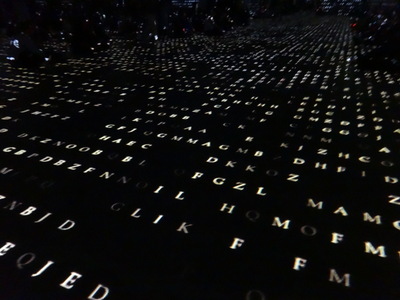
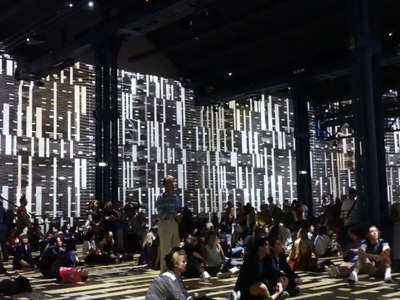 These two images are from Poetic AI. The letters marched endlessly across the floor, and other circuit-like and AI-specific images formed ever shifting moiré-like patterns around the walls and and chasing each other around the central cylinder.
These two images are from Poetic AI. The letters marched endlessly across the floor, and other circuit-like and AI-specific images formed ever shifting moiré-like patterns around the walls and and chasing each other around the central cylinder.
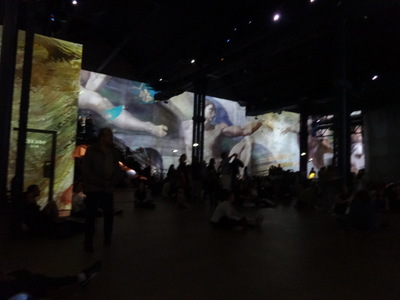
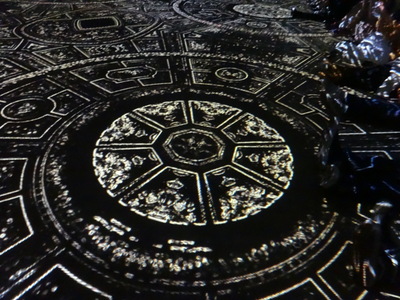 Then came the Klimt exhibition itself. It started out with some "establishing shots" presumably of Vienna of the time.
Then came the Klimt exhibition itself. It started out with some "establishing shots" presumably of Vienna of the time.
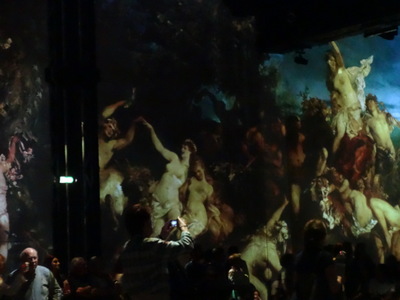
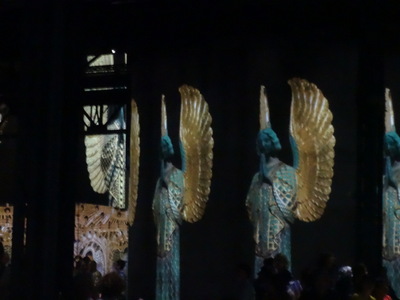 I wasn't actually sure whether the angels at the right here were Klimt or another establishing shot.
I wasn't actually sure whether the angels at the right here were Klimt or another establishing shot.
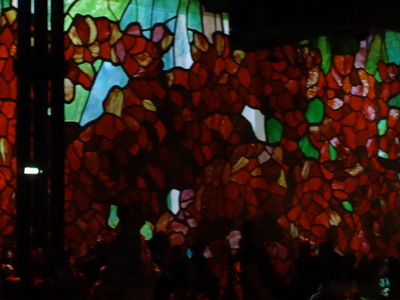
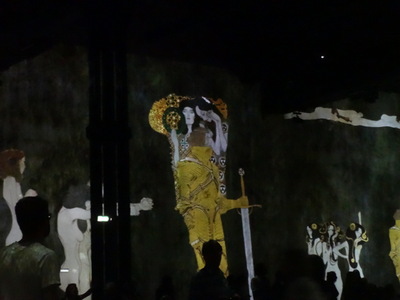 I'm afraid I know Klimt's work almost solely from the movie The Woman in Gold, so a great deal of what we saw was new to me. The video artists had chosen the accompanying music very carefully and had often dissociated different elements of the same painting, allowing them to move with respect to one aother, emphasizing their interrelationships. The red "stained glass" flowers flowed from left to right, and the elements of the tableau at the right arrived separately on the wall, slidng in from the side, or rising from the bottom.
I'm afraid I know Klimt's work almost solely from the movie The Woman in Gold, so a great deal of what we saw was new to me. The video artists had chosen the accompanying music very carefully and had often dissociated different elements of the same painting, allowing them to move with respect to one aother, emphasizing their interrelationships. The red "stained glass" flowers flowed from left to right, and the elements of the tableau at the right arrived separately on the wall, slidng in from the side, or rising from the bottom.
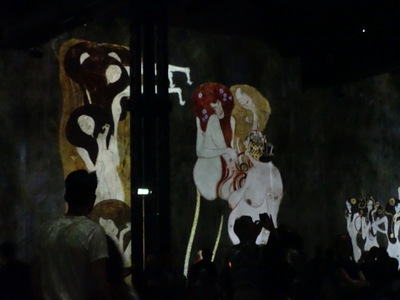
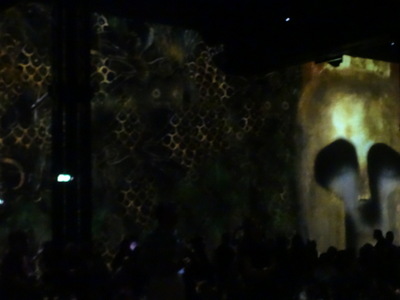 The one at the left here formed similarly and was then replaced by the empty helmet at the right, which, as it slid slowly up the wall . . .
The one at the left here formed similarly and was then replaced by the empty helmet at the right, which, as it slid slowly up the wall . . .
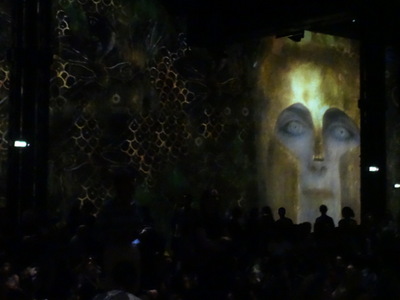
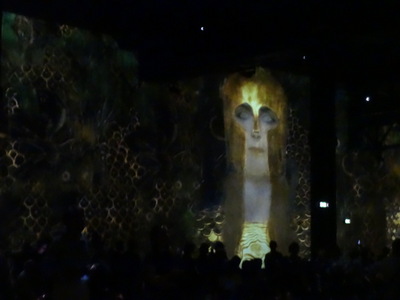 . . . was gradually filled by the haunting face that materialized within it.
. . . was gradually filled by the haunting face that materialized within it.
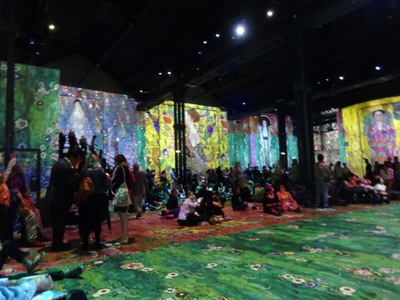
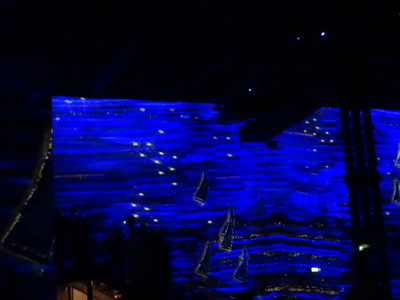 The image at the left here, where the room happened to be more brightly lit, gives an idea of the arrangements. You can see projection towers and all the people sitting or lying on the floor or strolling around while images follow one another across the wall. Note that all the color on the floor is also projected and also moving.
The image at the left here, where the room happened to be more brightly lit, gives an idea of the arrangements. You can see projection towers and all the people sitting or lying on the floor or strolling around while images follow one another across the wall. Note that all the color on the floor is also projected and also moving.
In the image at the right, the little sailboats actually sailed across the starry sea that formed their background. Charming!
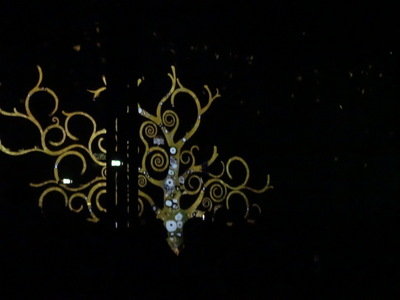
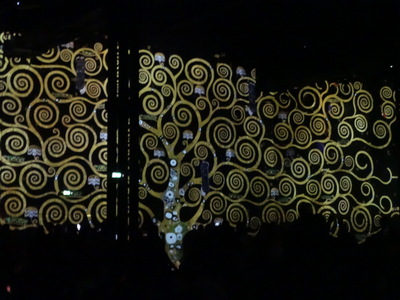 A single gold stem appeared at the bottom of the wall and then grew, gradually extending all its branches, which curled like tendrils into spirals before our eyes until the tree filled the entire vast wall.
A single gold stem appeared at the bottom of the wall and then grew, gradually extending all its branches, which curled like tendrils into spirals before our eyes until the tree filled the entire vast wall.
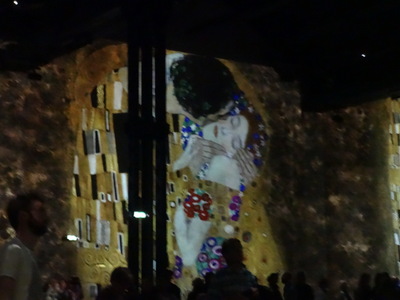
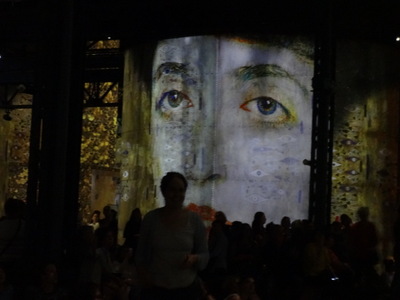 "The Kiss," which I'm told was Klimt's best-known work, at least until the movie about the Woman in Gold came out, appeared first on one wall, then migrated to another.
"The Kiss," which I'm told was Klimt's best-known work, at least until the movie about the Woman in Gold came out, appeared first on one wall, then migrated to another.
Adele, the woman in gold, made her first appearance in extreme close-up, . . .
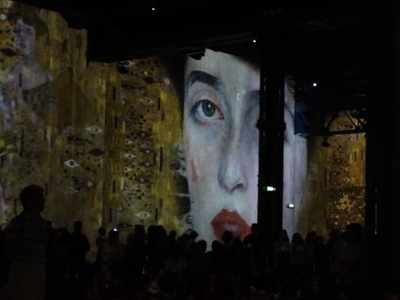
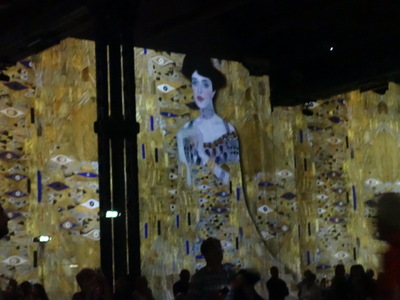 . . . then rose and receded until her whole figure appeared before she and her dress and background shattered into thousands of golden disks, which blew away off the wall, to be replaced with other images.
. . . then rose and receded until her whole figure appeared before she and her dress and background shattered into thousands of golden disks, which blew away off the wall, to be replaced with other images.
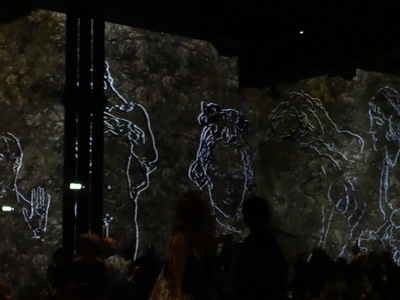
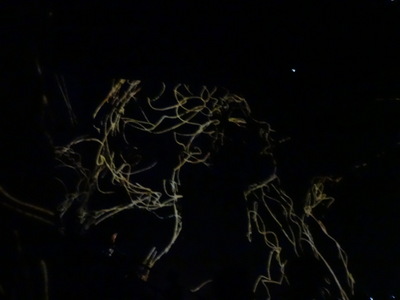 One series of images was of elegant line drawings that coiled and drew themselves before our eyes.
One series of images was of elegant line drawings that coiled and drew themselves before our eyes.
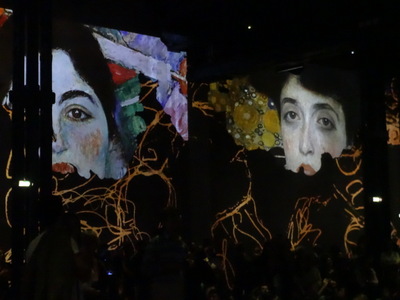
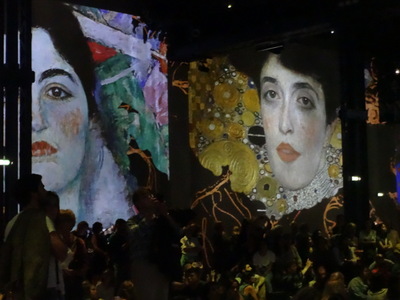 Adele reappeared in a particularly striking sequence in which the darkness melted off a wall like ink running down glass and gradually revealed the portraits of three women, these two and the young girl with the purple flower at the left below.
Adele reappeared in a particularly striking sequence in which the darkness melted off a wall like ink running down glass and gradually revealed the portraits of three women, these two and the young girl with the purple flower at the left below.
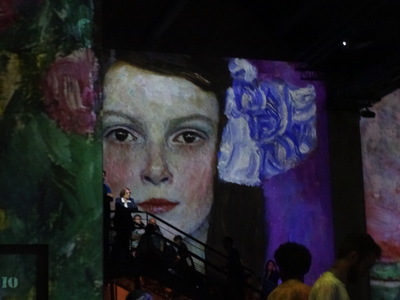
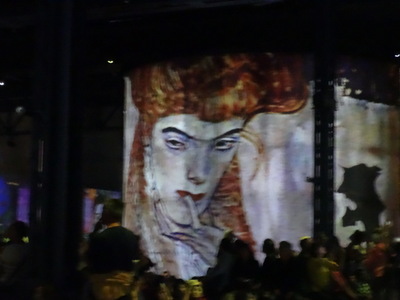 Were all three of these portraits stolen by the Nazis and then later restored?
Were all three of these portraits stolen by the Nazis and then later restored?
Meanwhile the rather sinister portrait at the right was projected on the central cylinder.
My descriptions represent only details here and there (and, of those, only the ones I got reasonable photos of). Images on all the walls, the floor, and the cylinder were in constant motion, coming and going, changing and migrating for at least an hour, for the Klimt portion alone. It was, as promised, a truly immersive experience, and it had the great effect of calling one's attention to the structure of the works and to details one might otherwise overlook. I highly recommend it!
When we finally emerged from the Atelier, it was still raining on and off, but we managed to get home reasonably dry.
For dinner, I had reserved at Au Trou Gascon, a restaurant serving food of southwestern France that we've loved for years. The original chef has gone on to greater things (and more Michelin stars), but he still owns the place, and his wife manages it, and the food has always been scrumptious and solidly reliable. We were puzzled by this year's review, which said that the food was still very good but that the service wasn't up to standard and that the decor was "sad and tired." What? Didn't they redecorate just a few years ago? We actually liked the old decor—dark wood and white plaster, gentlemen's club—better than the new one, which featured framed drawings of scrawny, caricatured women modeling excessively fasionable clothes of the 30's—the same drawings decorated the dishes. As I recall, the reviewer at the time liked the change.
An hour before we were due to leave the apartment, the skies opened and the rain poured down harder than I've ever seen it in Paris, but I was confident that Paris skies don't know how to rain that hard for very long—after all, this isn't Tallahassee, with the entire Gulf of Mexico to draw on.
Sure enough, it let up after a while, and I convince David we could still go by subway. We did (it's a straight shot from our local station), but it rained on us at both ends of the trip (fortunately, we had to walk around a good-sized construction site in the Place Felix Éboué, and the pedestrian walkway the builder had provided was covered. David grumbled that he was soaked (neither of our coats is as waterproof as it used to be), but we both dried out by the time the main course was served.
We're still baffled by the comments about the decor, which we found had changed again. That makes three different styles since we've been going there, so how sad and tired can it be? The new one is rather plain and definitely an improvement over the scrawny women. The original maître d' is gone, but I think we've seen the current one at least once before. He knows what he's doing, but the rest of the wait staff were pretty young and tentative. What makes me sad, though, is that the food has changed . . .
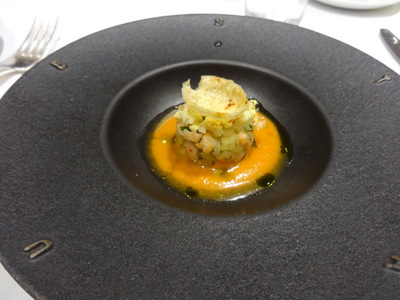
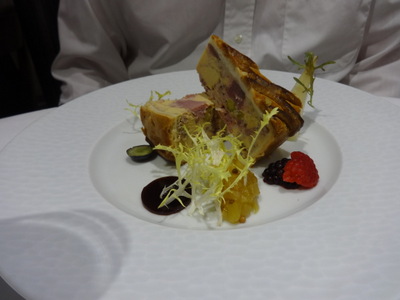 The amuse-bouche was a tasty cylinder of tiny "spiced shrimp" mixed with diced cooked cucumber, bell pepper, and chives, topped with finely diced hard-cooked egg and a hemispherical bit of crispy bread, all sitting on a purée of sweet potato. Yummy.
The amuse-bouche was a tasty cylinder of tiny "spiced shrimp" mixed with diced cooked cucumber, bell pepper, and chives, topped with finely diced hard-cooked egg and a hemispherical bit of crispy bread, all sitting on a purée of sweet potato. Yummy.
I wanted to start with the restaurant's famous cold foie gras, which I have long described as in a class by itself, better than any other in the city, but alas, it was missing from the menu! David ordered one of the two foie gras options, a cold terrine in which chunks of foie gras, cubes of duck meat, and pistachios were baked in a crust, then chilled. It was garnished with a disk of very rich aspic, a quenelle of an apple-mustard chutney, and several berries.
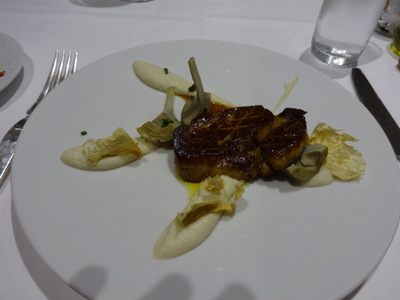
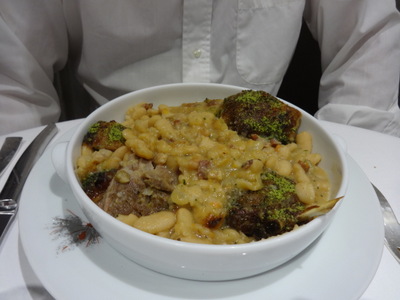 I ordered the other, which was a sautéed slice of foie gras, served hot, with artichoke purée, crispy artichoke chips, and warm baby hearts of artichoke. Very good indeed, but not a patch on the old stuff.
I ordered the other, which was a sautéed slice of foie gras, served hot, with artichoke purée, crispy artichoke chips, and warm baby hearts of artichoke. Very good indeed, but not a patch on the old stuff.
For his main course, David always orders the cassoulet, also the Parisian gold standard for that dish, and he ordered it again this time, even though the menu specified it was made with "haricots de maïs (corn beans?! What the heck is a corn bean? They wouldn't put actual corn in a cassoulet, would they? And what happened to the hypertraditional "haricots de Tarbe" they were always so proud of?). First, the portion size has been cut in half (fair enough, since no normal person could ever eat more than half of the original portion anyway); second, it had a lamb chop in it (okay, some people put lamb in cassoulet, but Trou Gascon never has); and third, it seemed to me that the beans (which turned out to be a smaller variant of haricots de Tarbe; I don't know what corn has to do with it) were not cooked uniformly—most had the usual lovely creamy texture, but some were distinctly firm. Sigh.
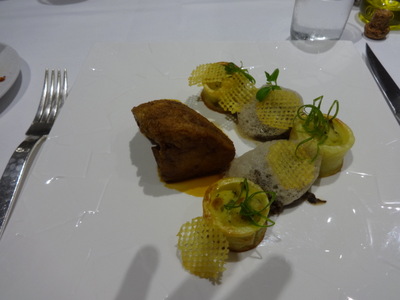
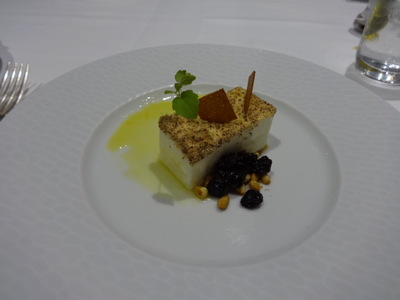 I ordered the crispy sweetbreads with creamy morels and potatoes "macaire." The sweetbreads were delicious, as were the morels (not a sauce, as I had pictured, but little molded cylinders of morels cooked in cream). The potatoes, which alternated on the plate with the cylinders of morels, were interesting—cylinders of cooked potato filled with mashed potatoes with something chopped up in them (more mushrooms, I think) and baked. They and the mushrooms were topped with a foam of something and with tiny waffle potato chips. The little green shreds were scallion tops very thinly sliced on the diagonal.
I ordered the crispy sweetbreads with creamy morels and potatoes "macaire." The sweetbreads were delicious, as were the morels (not a sauce, as I had pictured, but little molded cylinders of morels cooked in cream). The potatoes, which alternated on the plate with the cylinders of morels, were interesting—cylinders of cooked potato filled with mashed potatoes with something chopped up in them (more mushrooms, I think) and baked. They and the mushrooms were topped with a foam of something and with tiny waffle potato chips. The little green shreds were scallion tops very thinly sliced on the diagonal.
All very good, but I still found myself envying the folks at the next table over, who had ordered the roasted quarter of suckling lamb. Each one was really served a whole quarter of a very small lamb, cooked two different ways, and it looked terrific.
For the cheese course, we wanted to split a "faisselle pastoral," served with lemon honey, olive oil, and pine nuts. We pictured the usual tremblingly fragile cylinder of white cheese. The waiter seemed skeptical about our splitting one, saying that they were really quite small, but we persisted, and I suspect we got one each. But they were not what we expected at all. We each got a neat rectangle of a white substance with a slightly spongy, almost crumbly texture, topped with a couple of tiny square cookies and a lemon-balm sprout, served with raisins as well as they other stuff they promised. Not bad, but I wouldn't order it again.
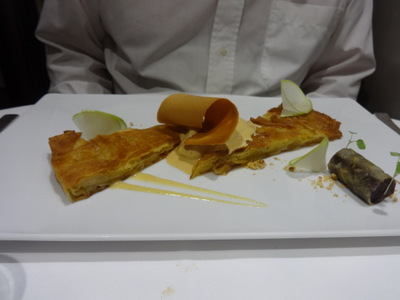
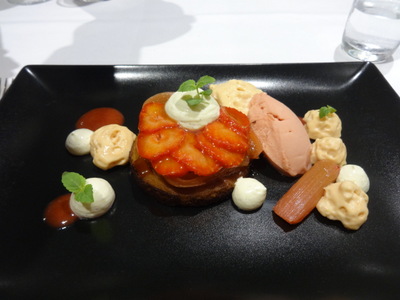 For dessert, David ordered the "fine tourtière Landaise," which when I last had it was a baked bundle of phyllo dough containing cooked apples and served with prunes soaked in Armagnac. This time, it was a very thin, flat apple tart, and the prunes were rolled up into a cylinder of something.
For dessert, David ordered the "fine tourtière Landaise," which when I last had it was a baked bundle of phyllo dough containing cooked apples and served with prunes soaked in Armagnac. This time, it was a very thin, flat apple tart, and the prunes were rolled up into a cylinder of something.
I had the strawberry-rhubarb dessert, a very tender flat cookie topped with stewed rhubarb and shingled with gariguette strawberries (my second favorite kind), served with another piece of rhubarb, guava purée, and whipped cream flavored with fruit (maybe more guava). Very yummy indeed.
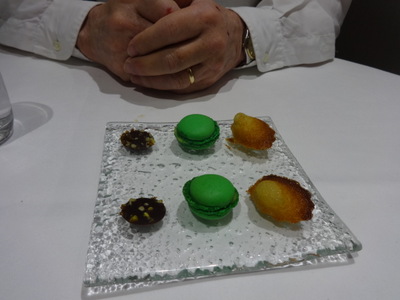 Finally, we were served a little plate of mignardises while we waited for the check—two each miniature madeleines, bright green macarons, and tiny chocolate disks studded with nuts. The macaron didn't tastes like much (certainly not lime or pistachio), but the madeleines were good and the chocolate was great. I ate all three of mine and David's chocolate—he didn't want any.
Finally, we were served a little plate of mignardises while we waited for the check—two each miniature madeleines, bright green macarons, and tiny chocolate disks studded with nuts. The macaron didn't tastes like much (certainly not lime or pistachio), but the madeleines were good and the chocolate was great. I ate all three of mine and David's chocolate—he didn't want any.
The rain came and went a couple of times while we ate, but we got home pretty much dry.
Previous entry
List of Entries
Next entry

 I finally woke David about noon, and we strolled to a nearby six-way intersection for lunch at a brasserie called Le Progres. He had a salad featuring greens, cold green beans, tomatoes, toast, and a slice of foie gras. I had one consisting of greens, green beans, lardons, slices of ham, croutons, and a poached eggs. Note, in the upper right corner of the photo, the clever metal bread basket that hangs off the edge of the table. Fortunately, the awning was wide enough that the bread did not stick out into the rain, although it was close. I thought I saw a name printed on the placemats that I recognized, so I looked it up on line later, and yes, the Progres is owned by Serge Blanco, former rugby player and now clothing tycoon and entrepreneur. For an account of our stay in his luxury hotel in Anglet, see my block entry at https://www.bio.fsu.edu/~thistle/blog06/06-06-29b.html.
I finally woke David about noon, and we strolled to a nearby six-way intersection for lunch at a brasserie called Le Progres. He had a salad featuring greens, cold green beans, tomatoes, toast, and a slice of foie gras. I had one consisting of greens, green beans, lardons, slices of ham, croutons, and a poached eggs. Note, in the upper right corner of the photo, the clever metal bread basket that hangs off the edge of the table. Fortunately, the awning was wide enough that the bread did not stick out into the rain, although it was close. I thought I saw a name printed on the placemats that I recognized, so I looked it up on line later, and yes, the Progres is owned by Serge Blanco, former rugby player and now clothing tycoon and entrepreneur. For an account of our stay in his luxury hotel in Anglet, see my block entry at https://www.bio.fsu.edu/~thistle/blog06/06-06-29b.html.
 The program consisted of a short subject (on the painter Friedrich Stowasser (1928–2000), better known by his pseudonym Friedensreich Regentag Dunkelbunt Hundertwasser), an even shorter subject called "Poetic AI," and the main feature on Klimt, and it was great; we sat through the whole thing twice. All of it was set, and often synchronized, to period- and theme-appropriate music.
The program consisted of a short subject (on the painter Friedrich Stowasser (1928–2000), better known by his pseudonym Friedensreich Regentag Dunkelbunt Hundertwasser), an even shorter subject called "Poetic AI," and the main feature on Klimt, and it was great; we sat through the whole thing twice. All of it was set, and often synchronized, to period- and theme-appropriate music.
 Here are two more Hundertwassers. At the left is the stern of a ship that has just sailed from right to left across the wall, as the buildings behind it remained stationary. You can see, e.g., its red and white smokestacks and its round portholes.
Here are two more Hundertwassers. At the left is the stern of a ship that has just sailed from right to left across the wall, as the buildings behind it remained stationary. You can see, e.g., its red and white smokestacks and its round portholes.
 These two images are from Poetic AI. The letters marched endlessly across the floor, and other circuit-like and AI-specific images formed ever shifting moiré-like patterns around the walls and and chasing each other around the central cylinder.
These two images are from Poetic AI. The letters marched endlessly across the floor, and other circuit-like and AI-specific images formed ever shifting moiré-like patterns around the walls and and chasing each other around the central cylinder.
 Then came the Klimt exhibition itself. It started out with some "establishing shots" presumably of Vienna of the time.
Then came the Klimt exhibition itself. It started out with some "establishing shots" presumably of Vienna of the time.
 I wasn't actually sure whether the angels at the right here were Klimt or another establishing shot.
I wasn't actually sure whether the angels at the right here were Klimt or another establishing shot.
 I'm afraid I know Klimt's work almost solely from the movie The Woman in Gold, so a great deal of what we saw was new to me. The video artists had chosen the accompanying music very carefully and had often dissociated different elements of the same painting, allowing them to move with respect to one aother, emphasizing their interrelationships. The red "stained glass" flowers flowed from left to right, and the elements of the tableau at the right arrived separately on the wall, slidng in from the side, or rising from the bottom.
I'm afraid I know Klimt's work almost solely from the movie The Woman in Gold, so a great deal of what we saw was new to me. The video artists had chosen the accompanying music very carefully and had often dissociated different elements of the same painting, allowing them to move with respect to one aother, emphasizing their interrelationships. The red "stained glass" flowers flowed from left to right, and the elements of the tableau at the right arrived separately on the wall, slidng in from the side, or rising from the bottom.

 The one at the left here formed similarly and was then replaced by the empty helmet at the right, which, as it slid slowly up the wall . . .
The one at the left here formed similarly and was then replaced by the empty helmet at the right, which, as it slid slowly up the wall . . .

 . . . was gradually filled by the haunting face that materialized within it.
. . . was gradually filled by the haunting face that materialized within it.

 A single gold stem appeared at the bottom of the wall and then grew, gradually extending all its branches, which curled like tendrils into spirals before our eyes until the tree filled the entire vast wall.
A single gold stem appeared at the bottom of the wall and then grew, gradually extending all its branches, which curled like tendrils into spirals before our eyes until the tree filled the entire vast wall.

 "The Kiss," which I'm told was Klimt's best-known work, at least until the movie about the Woman in Gold came out, appeared first on one wall, then migrated to another.
"The Kiss," which I'm told was Klimt's best-known work, at least until the movie about the Woman in Gold came out, appeared first on one wall, then migrated to another.
 . . . then rose and receded until her whole figure appeared before she and her dress and background shattered into thousands of golden disks, which blew away off the wall, to be replaced with other images.
. . . then rose and receded until her whole figure appeared before she and her dress and background shattered into thousands of golden disks, which blew away off the wall, to be replaced with other images.
 One series of images was of elegant line drawings that coiled and drew themselves before our eyes.
One series of images was of elegant line drawings that coiled and drew themselves before our eyes.
 Adele reappeared in a particularly striking sequence in which the darkness melted off a wall like ink running down glass and gradually revealed the portraits of three women, these two and the young girl with the purple flower at the left below.
Adele reappeared in a particularly striking sequence in which the darkness melted off a wall like ink running down glass and gradually revealed the portraits of three women, these two and the young girl with the purple flower at the left below.
 Were all three of these portraits stolen by the Nazis and then later restored?
Were all three of these portraits stolen by the Nazis and then later restored?
 The amuse-bouche was a tasty cylinder of tiny "spiced shrimp" mixed with diced cooked cucumber, bell pepper, and chives, topped with finely diced hard-cooked egg and a hemispherical bit of crispy bread, all sitting on a purée of sweet potato. Yummy.
The amuse-bouche was a tasty cylinder of tiny "spiced shrimp" mixed with diced cooked cucumber, bell pepper, and chives, topped with finely diced hard-cooked egg and a hemispherical bit of crispy bread, all sitting on a purée of sweet potato. Yummy.
 I ordered the other, which was a sautéed slice of foie gras, served hot, with artichoke purée, crispy artichoke chips, and warm baby hearts of artichoke. Very good indeed, but not a patch on the old stuff.
I ordered the other, which was a sautéed slice of foie gras, served hot, with artichoke purée, crispy artichoke chips, and warm baby hearts of artichoke. Very good indeed, but not a patch on the old stuff.
 I ordered the crispy sweetbreads with creamy morels and potatoes "macaire." The sweetbreads were delicious, as were the morels (not a sauce, as I had pictured, but little molded cylinders of morels cooked in cream). The potatoes, which alternated on the plate with the cylinders of morels, were interesting—cylinders of cooked potato filled with mashed potatoes with something chopped up in them (more mushrooms, I think) and baked. They and the mushrooms were topped with a foam of something and with tiny waffle potato chips. The little green shreds were scallion tops very thinly sliced on the diagonal.
I ordered the crispy sweetbreads with creamy morels and potatoes "macaire." The sweetbreads were delicious, as were the morels (not a sauce, as I had pictured, but little molded cylinders of morels cooked in cream). The potatoes, which alternated on the plate with the cylinders of morels, were interesting—cylinders of cooked potato filled with mashed potatoes with something chopped up in them (more mushrooms, I think) and baked. They and the mushrooms were topped with a foam of something and with tiny waffle potato chips. The little green shreds were scallion tops very thinly sliced on the diagonal.
 For dessert, David ordered the "fine tourtière Landaise," which when I last had it was a baked bundle of phyllo dough containing cooked apples and served with prunes soaked in Armagnac. This time, it was a very thin, flat apple tart, and the prunes were rolled up into a cylinder of something.
For dessert, David ordered the "fine tourtière Landaise," which when I last had it was a baked bundle of phyllo dough containing cooked apples and served with prunes soaked in Armagnac. This time, it was a very thin, flat apple tart, and the prunes were rolled up into a cylinder of something. Finally, we were served a little plate of mignardises while we waited for the check—two each miniature madeleines, bright green macarons, and tiny chocolate disks studded with nuts. The macaron didn't tastes like much (certainly not lime or pistachio), but the madeleines were good and the chocolate was great. I ate all three of mine and David's chocolate—he didn't want any.
Finally, we were served a little plate of mignardises while we waited for the check—two each miniature madeleines, bright green macarons, and tiny chocolate disks studded with nuts. The macaron didn't tastes like much (certainly not lime or pistachio), but the madeleines were good and the chocolate was great. I ate all three of mine and David's chocolate—he didn't want any.